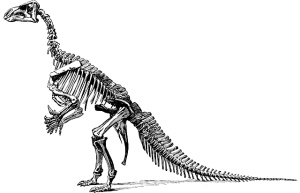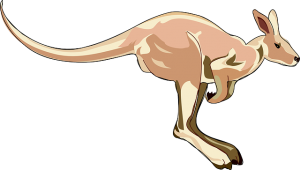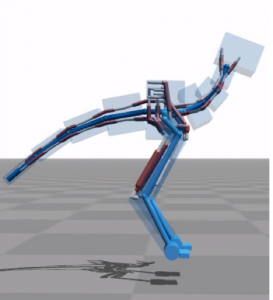Computers Discover How Animals Walk
by Amanda Lohmann
The same laws of physics govern the motion of every single animal on Earth, but different creatures get around in vastly different ways – gazelles bound, cheetahs run, lizards scamper. How – and why – have so many different animals come up with such different strategies for the same game? Thomas Geijtenbeek and A. Frank van der Stappen at Utrecht University in the Netherlands and Michiel van de Panne at the University of British Columbia in Canada might have just come up with a new way to find out. They’ve written a fascinating computer program that can look at the shape of a real or imaginary two-legged creature and figure out an efficient way for it to move forward. Here’s the resulting video:
[vimeo]https://vimeo.com/79098420[/vimeo]
To understand why their program is so important, let’s first take a look at the problems researchers studying animal movement tackle. Biomechanics is the study of how animals move and the physics behind those movements. However, looking only at the physics almost never tells the whole story. Questions of biomechanics are deeply tied up in questions of evolution. For example, consider the wheel. Humans use wheels in basically every mode of transportation we have – trains, bicycles, cars, scooters, shopping carts, and wheelchairs, just to name a few. However, no animal grows wheels instead of feet. Why? In a word, evolution. For a structure to evolve in an animal, its intermediate stages have to work. It’s easy to picture legs evolving – maybe they start as small, stumpy structures that help a tinycritter scoot along the bottom of the ocean, and they gradually get longer and longer over evolutionary time until we have long-legged animals able to run across the savannah. Now try to imagine a wheel evolving. No dice. A wheel has to start with a functional axle and has to work perfectly to be of any use – evolution could never gradually build up to a working wheel, because a wheel is either fully formed and fully functional and it’s useful, or it’s not a wheel and it doesn’t help the animal out.
So basically, it’s difficult to study biomechanics without thinking about evolution. An animal’s method of locomotion isn’t necessarily the best possible method – it’s just the method that was able to evolve.
In order to study evolution and biomechanics, many researchers have taken stabs at writing computer simulations that will “evolve” creatures that move. Computer programs can evolve animals by starting with an initial form provided by the researcher (or by a random generator), and then modifying it slightly in many different small ways, choosing the modified form that does best at whatever virtual task it’s given, and then modifying that best form slightly, and so on until many generations later you have a highly evolved virtual creature. One of the best examples is Karl Sims’ work from 1994 – a video way ahead of its time.
 However, the simulation techniques that biomechanics researchers have used in the past have been plagued with problems. The biggest setback is just that it’s extremely difficult to create a model with realistic constraints. A living animal has all sorts of limitations that computer models all too easily ignore. As if it weren’t already exceedingly complex to program a computer to understand how different types of muscle and bone and tissue move, there’s also much more to animal motion than just the physics the limbs and joints themselves. The physics of the signals sent between the brain and the muscles also plays a role. A computer model that ignores any of these crucial limitations on animal motion will give results that don’t make sense for real creatures, and therefore aren’t too helpful for researchers.
However, the simulation techniques that biomechanics researchers have used in the past have been plagued with problems. The biggest setback is just that it’s extremely difficult to create a model with realistic constraints. A living animal has all sorts of limitations that computer models all too easily ignore. As if it weren’t already exceedingly complex to program a computer to understand how different types of muscle and bone and tissue move, there’s also much more to animal motion than just the physics the limbs and joints themselves. The physics of the signals sent between the brain and the muscles also plays a role. A computer model that ignores any of these crucial limitations on animal motion will give results that don’t make sense for real creatures, and therefore aren’t too helpful for researchers.
What Geijtenbeek, van de Panne, and van der Stappen have done is created an extremely complex and sophisticated computer model of animal motion. They focused on two-legged creatures, and their simulation solved a lot of the problems that have typically beset similar attempts. For example, they managed to program in neural delay – that is, the miniscule (but not negligible!) amount of time it takes for the brain to send instructions to the muscles, and the equivalent amount of time it takes the brain to receive feedback (in the form of sensations) from the muscles. Even more excitingly, their model has an excellent and effective way of determining the best, most realistic way for muscles to be hooked up to nearby bones and other muscles. These connections between bones and muscles have been an obstacle for other simulations because previously, it’s been difficult to autogenerate these connections. In other words, in Geijtenbeek’s program, the researchers can basically give the program the locations of bones and muscles, and the program will create a realistic map of connections between bones and muscles. In previous programs, the researcher had to manually tell the computerwhere the points of connections between the bones and the muscles were, or had to settle for pretty mediocre and imperfect guesses by the computer. Geijtenbeek’s program’s ability to realistically predict where the connections would occur is a big deal because it means the researchers can give it forms of creatures that don’t exist or creatures that haven’t been extensively studied, and the computer will figure out how its muscles probably connect and can create realistic movements for it.
So okay, you may be saying, these Dutch people managed to program some pretty complex-sounding stuff. But why exactly is this so exciting? What can you actually do with what they wrote?
Well, partly it’s exciting just because it proves it can be done. We’re entering an era where you don’t have to film an animal using high-speed cameras and motion-capture techniques and then carefully enter physical data into a program which will generate a movement model – you can just take a picture of what an animal looks like and then study how it moves on a computer.
But even beyond that, however, are the results that this program has already shown. For example, check out how, in the video, a kangaroo-like creature starts to hop. The researchers didn’t suggest this movement to the computer – the program literally scanned through a host of motion options and decided that hopping was most efficient for the kangaroo-like body plan that the researchers had given it. This gives insight into one of the chicken-or-the-egg problems in biomechanics research: did form evolve first, or did function evolve first? In other words: Did kangaroos start doing jumping behavior because the jumping itself gave them some sort of evolutionary advantage, and then their body plan played evolutionary catch-up, slowly evolving to be better and better at hopping? Or did they first start evolving their current body plan because that body plan gave them an evolutionary advantage not related to jumping, and then they started evolving the jumping behavior because it was the most effective movement strategy for that body plan? Obviously, most situations are going to be a mixture of these two occurrences, but this computer model allows researchers to see that the behavior could definitely have evolved to fit the body plan.
Additionally, the modeled animals are fascinating because they show how well evolution did at evolving the best possible gaits. The fact that a computer independently arrived at almost identical solutions to those found in nature is utterly amazing.
This simulation and others based on it will provide incredible insight into both how animals move and how those movements evolved. Advanced computer simulations might someday be able to accomplish a wide variety of feats, from building robots capable of maneuvering on terrain that isn’t accommodating to wheels, to suggesting physical therapy approaches for patients with muscular or skeletal problems. The world of computer modeling is full of potential, and biomechanics researchers are just beginning to unlock a small part of it.
Sources:
Geijtenbeek, Thomas, Michiel van de Panne, and A. Frank van der Stappen. “Flexible muscle-based locomotion for bipedal creatures.” ACM Transactions on Graphics (TOG) 32.6 (2013): 206. DOI: 10.1145/2508363.2508399
Sims, Karl. “Evolving virtual creatures.” Proceedings of the 21st annual conference on Computer graphics and interactive techniques. ACM, 1994. DOI: 10.1145/192161.192167
